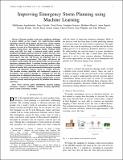Improving emergency storm planning using machine learning
Author(s)
Angalakudati, Mallikarjun; Calzada, Jorge; Gonynor, Jonathan; Raad, Nicolas; Schein, Jeremy; Warren, Cheryl; Williams, John; Papush, Anna Michelle; Monsch, Matthieu Frederic; Farias, Vivek F.; Perakis, Georgia; Whipple, Sean David; ... Show more Show less
DownloadNG_IEEE-Georgia-Perakis.pdf (601.0Kb)
OPEN_ACCESS_POLICY
Open Access Policy
Creative Commons Attribution-Noncommercial-Share Alike
Terms of use
Metadata
Show full item recordAbstract
Extreme weather events pose significant challenges to power utilities as they require very rapid decision making regarding expected storm impact and necessary storm response efforts. In recent years National Grid has responded to a large number of events in its Massachusetts service territory including Tropical Storm Irene and Hurricane Sandy. National Grid, along with MIT, has built a statistical model which predicts localized interruption patterns based on weather forecasts, asset information, historical damage patterns, and geography. National Grid expects that this will become an important tool in its emergency response preparations. This paper will discuss the predictive model which will aid National Grid in its preventative emergency planning efforts. A machine learning predictive algorithm was built by considering physical properties of the network, historical weather data, and environmental information to predict outages, and ultimately damage, based on weather forecasts. The machine learning algorithm will continuously improve in granularity and accuracy through its continued use and the incorporation of additional information. As a data-driven model it provides an invaluable tool for decision making before a storm, which is currently motivated primarily by intuition from industry experience.
Date issued
2014-07Department
Massachusetts Institute of Technology. Institute for Data, Systems, and Society; Massachusetts Institute of Technology. Operations Research Center; Sloan School of ManagementJournal
2014 IEEE PES T&D Conference and Exposition
Publisher
Institute of Electrical and Electronics Engineers (IEEE)
Citation
Angalakudati, Mallikarjun, Jorge Calzada, Vivek Farias, Jonathan Gonynor, Matthieu Monsch, Anna Papush, Georgia Perakis, et al. “Improving Emergency Storm Planning Using Machine Learning.” 2014 IEEE PES T&D Conference and Exposition (April 2014), Chicago, IL, USA, Institute of Electrical and Electronics Engineers (IEEE), 2014.
Version: Author's final manuscript
ISBN
978-1-4799-3656-4
978-1-4799-3657-1
ISSN
2160-8563
2160-8555